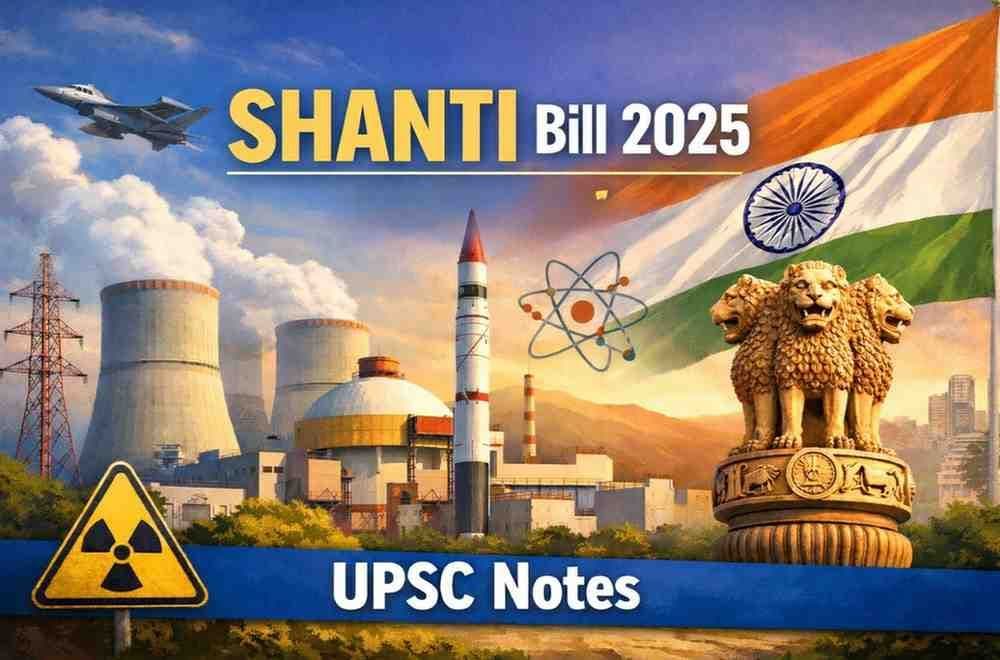Current Affairs 2024 - Giving shape to India’s carbon credit mechanism
Feb, 2025
•3 min read
Introduction
Carbon markets are pivotal in achieving global climate targets by incentivizing greenhouse gas (GHG) reductions. As COP-29 in Baku highlights the role of carbon finance, India, with its updated Nationally Determined Contributions (NDCs) and ambitions for a domestic carbon market, is poised to lead global climate action.
However, challenges like ensuring integrity, alignment with Article 6 of the Paris Agreement, and regulatory robustness need to be addressed.

What are Carbon Credits?
- Definition: Tradable certificates representing avoided or removed GHG emissions, equivalent to one metric ton of CO₂.

- Purpose: Allow entities to transfer and "retire" credits to meet climate targets or contribute to mitigation.
- Certification: Issued by governments or independent bodies, adhering to standardized Global Warming Potentials (GWPs).
- Uses: Serve compliance or voluntary reporting and support broader climate mitigation efforts.

Opportunities for India in Developing a Domestic Carbon Market
- Economic Growth:
- India issued 278 million credits between 2010–2022, accounting for 17% of global supply.
- Potential to create 200,000+ jobs, boost green finance, and support the $5 trillion economy target.
- International Climate Leadership:
- As a top emitter and renewable energy leader, India can shape global climate finance frameworks.
- Initiatives like the International Solar Alliance highlight India’s leadership potential.
- Industrial Competitiveness:
- Carbon pricing drives modernization, innovation, and efficiency.
- Examples: EU-ETS reduced industrial emissions by 41% (2005–2022); JSW Steel leads in low-carbon solutions.
- Digital Integration:
- India’s digital success (UPI, CoWIN) offers a template for carbon trading platforms.
- Blockchain, IoT, and AI can enhance transparency and reduce verification costs.
- Green Investment Catalyst:
- Carbon markets can attract ESG investments (~18% of foreign financing in emerging markets).
- Supports green bonds and initiatives in renewable energy, efficiency, and conservation.
- Rural Development:
- Farmers can earn additional income through carbon farming (e.g., Maharashtra pilot projects).
- Encourages agroforestry, sustainable agriculture, and rural renewable energy projects.
- Sectoral Transformation:
- Opportunities across energy, manufacturing, real estate, and transport sectors.
- Performance Achieve Trade (PAT) scheme shows industry readiness for market mechanisms.
- Knowledge Economy Development:
- Carbon markets foster expertise in accounting, trading, and climate finance.
- Initiatives like the Climate University Network (100+ universities) build skills and research capacity.
- Urban Sustainability:
- Projects in waste management, clean transport, and urban forestry boost sustainable urban development.
- Examples: Indore’s success in generating revenue from waste carbon credits.
Challenges in Developing Carbon Markets in India
- Market Design:
- Balancing environmental goals with economic realities is complex.
- Uniform pricing mechanisms are difficult due to diverse industrial capacities.
- Measurement & Verification:
- Inadequate emissions data and monitoring systems hinder credibility.
- MSMEs lack technical capacity for accurate reporting.
- Regulatory Gaps:
- Implementation delays (e.g., Green Credit Programme) expose institutional constraints.
- Coordination between multiple agencies creates operational inefficiencies.
- Industry Readiness:
- High compliance costs may exclude MSMEs, creating market distortions.
- Gaps in carbon accounting and trading expertise across sectors.
- International Alignment:
- Balancing sovereignty and global standards (Article 6 compliance) is challenging.
- Risks of carbon leakage and competitiveness concerns require careful policy design.
- Credit Integrity Issues:
- Double counting and additionality concerns undermine market credibility.
- Overlapping schemes like PAT and RECs complicate tracking mechanisms.
- Regional Disparities:
- Market benefits may concentrate in industrialized states, neglecting underdeveloped regions.
- Equity concerns require inclusive mechanisms.
- Technology Gaps:
- Secure, transparent trading platforms need significant investment.
- Digital divides across regions and industries hinder participation.
- Speculation & Greenwashing:
- Risk of price manipulation and misuse of offsets (e.g., "phantom credits").

- Ensuring market credibility is critical for consumer trust.
Measures to Accelerate Carbon Market Development
- Phased Implementation:
- Begin with high-emission sectors and expand gradually.
- Build capacity through a tiered approach similar to China’s Emissions Trading System.
- Digital Infrastructure:
- Use blockchain for transparent tracking and IoT for real-time monitoring.
- Standardized digital reporting formats reduce transaction costs.
- Capacity Building:
- Develop certification programs for carbon market professionals.
- Establish guidance for emissions reporting and sectoral pathways.
- Dynamic Pricing:
- Introduce price collar mechanisms to prevent volatility.
- Use market stability reserves to balance supply-demand dynamics.
- Sectoral Integration:
- Link PAT, RECs, and carbon markets to prevent overlap.
- Create compliance mechanisms for hard-to-abate sectors.
- Regional Frameworks:
- State-level carbon market cells to provide localized support.
- Revenue-sharing models to incentivize state participation.
- International Alignment:
- Align market rules with Article 6 and establish frameworks for credit transfers.
- Strengthen bilateral partnerships for capacity building.
Conclusion
India’s carbon market is a transformative step toward sustainable development, aligning with SDG 13: Climate Action. By addressing design, regulatory, and technological challenges, it can drive emissions reductions, attract green investments, and position India as a global climate leader.

![Sabka Bima Sabki Raksha: New Insurance Bill [2025]](/_next/image?url=https%3A%2F%2Fblog-media.superkalam.com%2FSabka_Bima_Sabki_Raksha_New_Insurance_Bill_f66a1e45d1.jpeg&w=3840&q=75)
![MGNREGA Vs VB-G RAM G [UPSC 2025]](/_next/image?url=https%3A%2F%2Fblog-media.superkalam.com%2FG_RAM_G_32a42966ea.jpeg&w=3840&q=75)